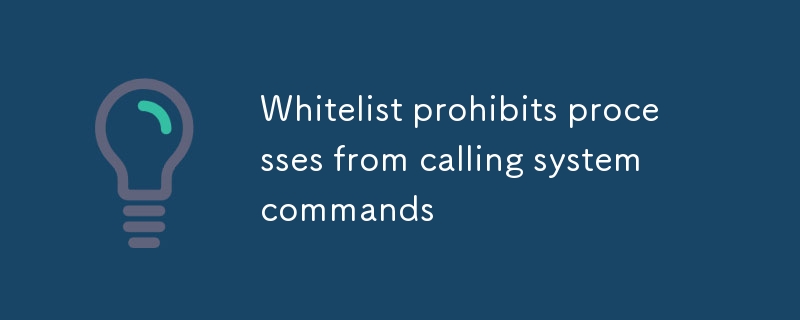이 문서에서는 시스템 명령을 호출하지 못하도록 금지된 프로세스를 화이트리스트에 추가하는 방법에 대해 설명합니다. 금지된 프로세스를 화이트리스트에 추가하면 중요한 시스템 명령에 대한 무단 액세스를 방지하여 보안 위반 및 데이터 유출을 줄이는 데 도움이 됩니다. 이 기사에서는

시스템 명령 호출에서 금지된 프로세스를 화이트리스트에 추가
시스템 명령 호출에서 금지된 프로세스를 화이트리스트에 추가하는 방법?
시스템 명령 호출에서 금지된 프로세스를 화이트리스트에 추가하려면를 사용할 수 있습니다. auditd도구를 사용하면 특정 프로세스가 특정 명령을 실행하도록 허용하는 규칙을 만들 수 있습니다. 방법은 다음과 같습니다.auditdtool to create a rule that allows specific processes to execute certain commands. Here's how you can do it:
/etc/audit/rules.d/whitelist.ruleswith the following content:-w /usr/bin/command -p x -c neverIn this rule,/usr/bin/commandis the command that you want to whitelist,-p xspecifies that the rule applies to processes with executable permission, and-c neverspecifies that the rule should never be enforced. You can add multiple rules to the file, each on a separate line.
auditdsystem by running the following command:sudo auditctl -R /etc/audit/rules.d/whitelist.rulesauditd:To ensure that the rules are applied immediately, restartauditdby running:sudo systemctl restart auditdWhat are the benefits of whitelisting forbidden processes?
Whitelisting forbidden processes can help prevent unauthorized access to sensitive system commands. By restricting the ability of certain processes to execute specific commands, you can reduce the risk of security breaches and data leaks.
What are some examples of forbidden processes?
Forbidden processes are typically processes that are not essential for the operation of the system and that could be used to compromise the system if they were allowed to execute certain commands. Examples of forbidden processes include:
How can I audit forbidden processes?
You can audit forbidden processes by using theauditctltool. To do this, run the following command:
sudo auditctl -w /usr/bin/command -p x -c idThis command will create an audit rule that logs all attempts by processes with executable permission to execute the/usr/bin/command
/etc/audit/rules.d/whitelist.rules라는 파일을 만듭니다.sudo cat /var/log/audit/audit.log | grep /usr/bin/command/usr/bin/command는 허용 목록에 추가하려는 명령이고,
-p x는 규칙이 적용되는 대상을 지정합니다. 실행 권한이 있는 프로세스이며
-c never는 규칙이 적용되지 않도록 지정합니다. 파일에 여러 규칙을 각각 별도의 줄에 추가할 수 있습니다.
auditd시스템에 로드합니다. 다음 명령:auditd다시 시작: 규칙이 즉시 적용되도록 하려면auditd를 다시 시작하세요.실행:auditctl도구를 사용하여 금지된 프로세스를 감사할 수 있습니다. 이렇게 하려면 다음 명령을 실행하세요.rrreee이 명령은
/usr/bin/command명령을 실행하기 위한 실행 권한이 있는 프로세스의 모든 시도를 기록하는 감사 규칙을 생성합니다. 다음 명령을 실행하여 감사 로그를 볼 수 있습니다.rrreee
위 내용은 화이트리스트는 프로세스가 시스템 명령을 호출하는 것을 금지합니다.의 상세 내용입니다. 자세한 내용은 PHP 중국어 웹사이트의 기타 관련 기사를 참조하세요!